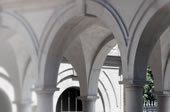
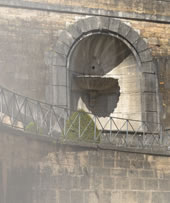
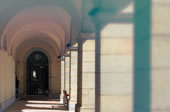
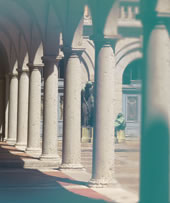
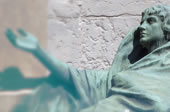
- aFont size -
- AFont size +
- PrintPrint this page
- version pdfPage in PDF format
Buildings
Facilities
The CNSMD occupies a remarkable historic building dating back to the 17th century. The Convent of the Ladies of Saint Elizabeth, which became the Lyon Veterinary School after the French Revolution, has been updated with additions in the modern architectural idiom.
There are 110 teaching rooms, together with performance rooms that include the Salle Varèse, the Ensemble Room and the Darasse Lecture Theatre (organ room).
RESTRICTED MOBILITY AccesS
Work is currently underway to improve access for people with mobility impairment. The Salle Varèse and the Ensemble Room are now have restricted mobility access. Please contact Lyon CNSMD beforehand so that your visit goes smoothly when you attend our events.
SALLE VARÈSE
A 280-seat auditorium named after the famous composer Edgar Varèse. It is equipped with a professional audio-visual control room and is used for most of the events of the conservatory’s public season.
ENSEMBLE ROOM
The room seats fifty and is used only for small ensembles (recitals and chamber music).
There are special sound facilities and a control room.
Darasse LECTURE THEATRE (ORGAN ROOM)
The Darasse Lecture Theatre was originally known as the Chabrol Lecture Theatre. It was given its present name in memory of the first organ teacher at the CNSMD, Xavier Darasse. It has housed the Grenzing organ since 1993.
In constant demand for teaching and concerts, the organ is suitable for chamber music thanks to its style and voicing, which also permit its use for early music. Jean Boyer underlined the original conception of the instrument in his brilliant analysis in the inauguration programme:
The organ at the CNSMD was the fruit of the imagination of Xavier Darasse. His plan was ambitious: an instrument that would have to have character but would also be extremely versatile. The model chosen was an 18th century organ from Saxony displaying the features of several different aesthetic styles, which was unusual in such an early instrument. One of the main characteristics was the variety of the foundation stops and the way they could be combined. It was nevertheless decided not to limit the project to a mere copy of a historic instrument. The sound colour would have to be specially created, albeit within the constraints of the initial project and of the dimensions other room where the organ was going to be placed. The particularly delicate matter of the voicing required exceptional skill.
Gerhard Grenzing was commissioned to build and finalise the conception of the instrument. He took up the challenge and went far beyond the stated objective because the instrument he created is an absolute masterpiece of organ-building. The organ is a suspended tracker action instrument with three manuals and a pedalboard. The specifications were established by Jean-Pierre Decavèle, the organ-case was designed by Walther Laible and the paintwork is by Bernard Sibieude. There are thirty-seven stops:
- Great (middle manual, 56 notes): 16’ bourdon, 8’ montre, 8’ chimney bourdon, 4’ prestant, 4’ flauto dolce, 2’ doublette, 2 2/3’ quint, 1 3/5’ tierce, 3-rank cornet, 5-rank furniture, 8’ trumpet.
- Positive (top manual, 56 notes): 8’ bourdon, 8’ gamba, 4’ viol, 4’ petit bourdon, 2’ doublette, 1 1/3’ larigot, 1’ sifflet, 2-rank sesquialtera, 8’ vox humana.
- Swell (lowest manual, 56 notes) : 8’ flute, 8’ cor de chamois, 8’ quintaton, 4’ chimney flute, 4’ prestant, 2’ doublette, 2’ quarte, 2 2/3’ nasard, 2-rank terzian (tiercelette), 3-rank cymbal, 8’ dulzian (douçaine).
- Pedal (30 notes): 16’ soubasse, 8’ flute, 4’ prestant, 3-rank furniture, 16’ bombardon, 8’ trumpet.
OTHER FACILITIES
The department of writing and composition has the use of seven studios, a 750 sq ft variable acoustic experimental studio adjacent to a multi-track recording studio and of a concert recording studio. All these facilities are interconnected in a computer network and use the 5.1 digital audio standard.
There is also a restaurant and a student residence at the CNSMD.
THE GARDENS
The buildings are surrounded by magnificent gardens, which were used for study purposes by the former veterinary school and contain some remarkable trees, including a Virginia tulip tree, a mulberry and a ginkgo biloba.
The two scuptures entitled Souffle de feuilles (Leaves in the Breeze) and Dessin de pierre (Drawing in Stone) were financed by the ‘1% for art’ which is an integral part of every state building project. The contract was awarded to Giuseppe Penone.
It is not so much a single work as two complementary creations. ‘Leaves in the Breeze’ is supported by five graceful tree-trunks, a calque of trees among trees in gilded bronze as shiny as orange peel. ‘Drawing in Stone’ communicates with the exterior through a bronze mouth which is prolonged into a winding copper tube. The tube ends in a mould of the inside of Penone’s mouth with large lips in the shape of a vegetable bulb. The mouth projects a black whirlwind of leaves against the wall.
Direct access


